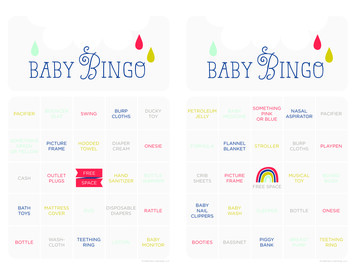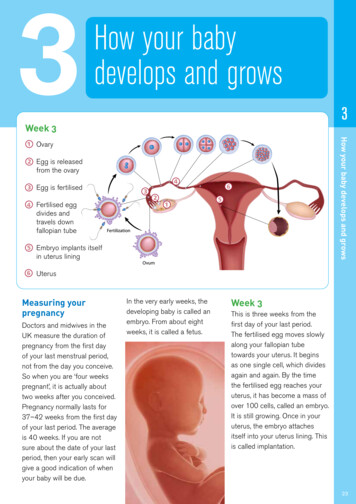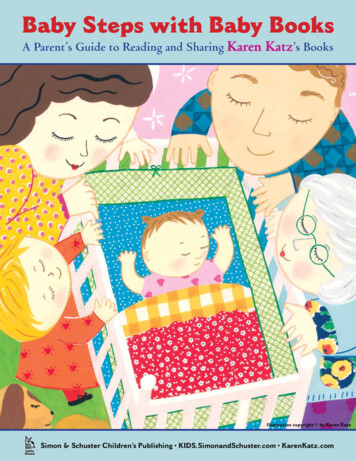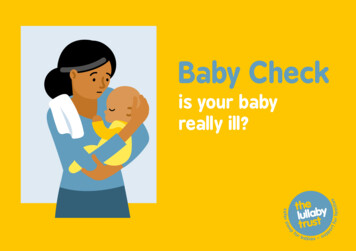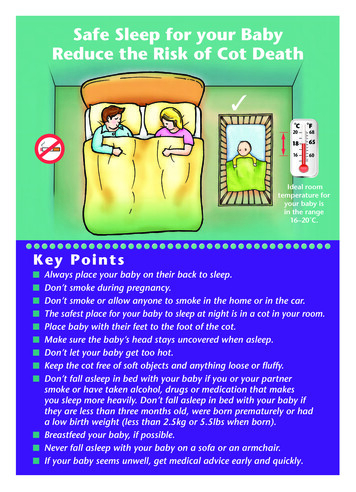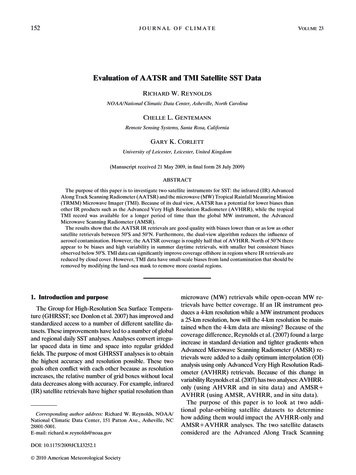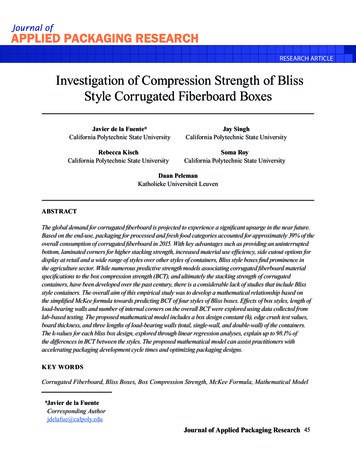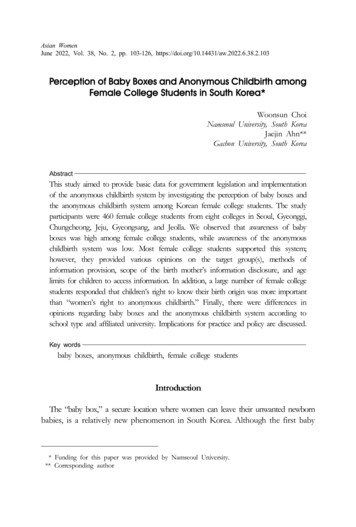
Transcription
Asian WomenJune 2022, Vol. 38, No. 2, pp. 103-126, ion of Baby Boxes and Anonymous Childbirth amongFemale College Students in South Korea*1Woonsun ChoiNamseoul University, South KoreaJaejin Ahn**Gachon University, South KoreaAbstractThis study aimed to provide basic data for government legislation and implementationof the anonymous childbirth system by investigating the perception of baby boxes andthe anonymous childbirth system among Korean female college students. The studyparticipants were 460 female college students from eight colleges in Seoul, Gyeonggi,Chungcheong, Jeju, Gyeongsang, and Jeolla. We observed that awareness of babyboxes was high among female college students, while awareness of the anonymouschildbirth system was low. Most female college students supported this system;however, they provided various opinions on the target group(s), methods ofinformation provision, scope of the birth mother’s information disclosure, and agelimits for children to access information. In addition, a large number of female collegestudents responded that children’s right to know their birth origin was more importantthan “women’s right to anonymous childbirth.” Finally, there were differences inopinions regarding baby boxes and the anonymous childbirth system according toschool type and affiliated university. Implications for practice and policy are discussed.Key wordsbaby boxes, anonymous childbirth, female college studentsIntroductionThe “baby box,” a secure location where women can leave their unwanted newbornbabies, is a relatively new phenomenon in South Korea. Although the first baby* Funding for this paper was provided by Namseoul University.** Corresponding author
104 Woonsun Choi Jaejin Ahnbox was established in December 2009 by a church minister in Seoul, it has becomewidely known to the public since 2011 with the amendments to the AdoptionLaw (“Act on Special Cases Concerning Adoption”). This law, which came intoeffect in August 2012, drastically changed South Korea’s adoption practices. Thenew adoption law requires birth registration of the baby before the commencementof the adoption process, which places a considerable burden on birth mothers—mostlyyoung, unmarried women—experiencing unwanted pregnancy and childbirth. Beforethe amendment, it was a customary practice, although illegal, for birth mothersto leave their babies with an adoption agency without birth registration, and foradoptive parents to register them as birth children after adoption. This traditionalpractice provided the opportunity for anonymous birth in South Korea (Lee, 2017).However, the new adoption law requires that permission be sought from the FamilyCourt as part of the adoption process and the child’s birth certificate is one ofthe documents that must be submitted to the Family Court.Owing to the social stigma associated with births out of wedlock in SouthKorea, unmarried mothers are reluctant to reveal their pregnancies and childbirths, even to their family and friends. Registering the child’s birth may endanger their secret. Thus, desperate mothers abandoned their babies insteadof entrusting them to an adoption agency. The number of babies found inthe baby box has increased significantly since 2012. In March 2010, the firstbaby was found in the baby box and four babies were submitted during theentire year. This increased to 37 in 2011 and 79 in 2012, peaking at 280 in2014 as the baby box received media attention in 2013, and another churchin Gunpo, Gyeonggi, set up a second baby box in 2014 (Lee, 2017). The total number of children found in the first baby box between March 2010 andJune 2016 was 1,186 (Hyun, Lim, & Ahn, 2017). However, baby boxes inSouth Korea lack a legal basis; several debates exist surrounding them, withlocal government repeatedly warning the church to stop running them.Baby-box supporters insist that it protects children’s lives by protecting theanonymity of the mothers and saves desperate mothers from the stigma related to birth out of wedlock. In contrast, those opposed to the baby boxcriticize the fact that it aids or induces the abandonment of babies and infringes upon the child’s right to know their origins.The UN Convention on the Rights of the Children (UNCRC) recognizes thata child should be registered immediately after birth and has the right to knowand be cared for by their parents (Article 7). The UNCRC (2014) has expressedits serious concerns about the baby-box program and urged nations that run such
Asian Women 2022 Vol.38 No.2 105schemes to shut them down. However, closing down baby boxes without legitimatealternatives may endanger the children’s lives, which violates the children’s rightto survival and development expressed in the UNCRC (Article 6). Additionally,an inordinate emphasis on children’s rights to know their origin may conflict withthe right of women to choose anonymity regarding their births.Given the insufficient support afforded single mothers, it would be impracticalto compel all young unmarried mothers to rear their children. Furthermore, therequirement of birth registration for the adoption process imposes a psychologicaland emotional burden on unmarried mothers. Thus, a balanced consideration ofboth children’s and women’s rights is needed to appropriately protect both groups’rights.Historically, baby boxes and anonymous births have been used worldwide asmeasures to help women in similar situations, usually those undergoing an unwantedpregnancy and wanting to relinquish their child after birth. In South Korea, thebaby box has been a matter of contention since its establishment in 2009 anda universal birth registration system and anonymous births have been suggestedas alternatives.Under the universal birth registration system, also called the birth notificationsystem, health care professionals must register babies born in hospitals with thenational birth registration system. Since birth registration is a parental responsibility,several newborns remain unregistered in the system and abandoned by their parents.If a universal birth registration system were introduced, it would be impossiblefor parents to leave a baby in a baby box. There are also concerns that a universalbirth registration system would prevent unmarried women from opting for hospitaldelivery so as to avoid having the child’s birth registered, possibly endangeringthe lives of both mother and child. Thus, several attempts to legislate for anonymousbirths have been made in the last decade in South Korea’s National Assembly1(Hyun et al., 2017), but these bills failed to pass because of a lack of socialconsensus regarding the necessity and validity of the anonymous birth system.To establish a legal system that safeguards vulnerable groups of mothers and children,agreement among members of society is required as a prerequisite. Although somecountries have already established similar baby-box programs or anonymous birthsystems, differences in cultural background mean some countries’ perceptions of1 For more detailed information about the bills submitted to the National Assembly, see Hyun etal. (2017)
106 Woonsun Choi Jaejin Ahnchildbirth out of wedlock may differ (Lee & Kim, 2019). Thus, it is necessaryto understand social perceptions of baby boxes and anonymous births before formulating relevant policies.Few studies have examined social perceptions of baby boxes and/or anonymous births in South Korea or other countries. One study examined the socialperceptions of baby boxes and infant abandonment among young people in Koreaand found that positive perceptions of baby boxes were slightly higher than negative perceptions; however, toleration of infant abandonment was generally low(Lee & Kim, 2019). Attitudes toward infant abandonment differed by respondents’age, education level, marital status, and employment status, with older, highly educated, married, and employed persons less tolerant of the practice (Lee & Kim,2019). Similarly, a survey of professionals (staff members or researchers in thefield) was conducted in 2017. The majority agreed on the necessity of an anonymous birth system, with some preconditions such as counseling for the mothers,ensuring children’s access to birth information, and expanding support for singlemothers (Hyun et al., 2017). Although the target groups in both cases were limited,these studies are nevertheless significant in that they attempted to reveal the socialperceptions of baby boxes and anonymous births.Once an anonymous birth system is introduced, the largest potential user groupwould be young unmarried mothers. Examining the opinions of the people mostconcerned with the issue would help discern the possible strengths and weaknesses of the system. This study therefore aimed to provide basic data for government legislation and implementation of an anonymous childbirth system by investigating perceptions of baby boxes and the anonymous childbirth system amongKorean female college students.Question 1. How do female college students perceive baby boxes?Question 2. How do female college students perceive the anonymous childbirth system?Question 3. Do perceptions of baby boxes and anonymous childbirth systemvary depending on the general characteristics of female college students?Literature ReviewThe history of infant abandonment goes back further than expected, even as faras ancient Greeks and biblical times (Choi, 2017). Depending on a country’s cul-
Asian Women 2022 Vol.38 No.2 107tural and historical background, diverse societal measures have been developed tosolve the problems of unwanted pregnancy and baby abandonment. The mostcommon types of measures have been the baby box and anonymous birth programs, although the name and operational system of such programs may differ bycountry.Although the main subject of this study is societal perceptions of the socialmeasures tackling infant abandonment, few studies have addressed societal perceptions of baby boxes and/or anonymous births. This could be because of thelong history of these programs, which were established based on religious valuesor ideas of the sanctity of life. Thus, the laws and programs of countries with established systems dealing with these issues were examined in this section, with reference to the stance of the UNCRC. Three countries—France, Germany, and theUnited States—with heterogeneous programs are examined for comparativepurposes. France has a long tradition of an anonymous birth system, still in use today, and Germany has developed both an advanced anonymous birth system,termed “confidential birth,” and a baby-box program (Babyklappe). The UnitedStates has a legalized baby-box program called “Safe Haven.”FranceHistorically, France is the only Western country that has granted full anonymityto mothers, and where anonymous free births have been legally guaranteed (Choi,2017). With the legalization of anonymous births, baby boxes were naturallyremoved. Thus, the anonymous birth system is France’s only solution to babyabandonment.In France, any pregnant woman who requests secrecy in the hospital can leavetheir child at the hospital without any identifying information under the Act ofAccouchement sous X (Anonymous Birth) enacted in 1941. However, these womenare required to be fully informed of the legal consequences of their decision by lawand are encouraged to keep the child. Since the changes in the law in 2001, mothers who opt for anonymous birth must be informed of the importance of knowingone’s origins and history and provided with counseling about the services availableto raise their child during and after relinquishing their child (Bartels, 2012). Theyare also invited to provide information about the birth and their details in writingand to deposit this information in a sealed envelope. This information can be provided or supplemented at a later date. However, they are subject to very little coercion and can remain anonymous, at least during their lifetime, if they wish to
108 Woonsun Choi Jaejin Ahn(Hadžimanović, 2018). Despite the reinforcement of counseling and efforts tomake the search for origins easier by law, opinions on the desirability of anonymous birth are divided in France, as they are in other countries allowing anonymous birth. Opponents of anonymous birth emphasize the child’s right to knowtheir origin and insist that not knowing one’s roots causes great suffering, whichcan affect one’s identity formation (Choi, 2017; Lefaucheur, 2004). Conversely,supporters of anonymous births argue that it protects both the mother and thechild (Choi, 2017; Lefaucheur, 2004). They also insist that the mother’s rights supersede those of the child, since the survival of infants is solely dependent uponthe mother’s decision during the early stages of life (Choi, 2017).Despite these controversies, the European Court of Human Rights approvedthe French system of anonymous births in 2003 in the famous case of Odièvre v.France. According to the European Court of Human Rights, the French system ofanonymous birth legitimately balances the rights of the mother and child since themother is encouraged to leave non-identifying information for the child and is entitled to reveal her identity at a later date (Simmonds, 2013). In addition, theFrench Conseil Constitutionnel decided in its judgment on May 16, 2012, that the legal provisions of January 22, 2002, allowing anonymous birth in France, are notunconstitutional (Hadžimanović, 2018). However, the UNCRC takes a differentstance and recommends that state parties remove the requirement of the biologicalmother’s consent to reveal her identity and increase efforts to prevent anonymousbirth by addressing the basic causes of parents’ choices (Hadžimanović, 2018).GermanyGermany operates both a baby box and confidential birth (a modified form ofanonymous birth) program. The anonymous birth system became a confidentialbirth in 2014 with the passing of related legislation.The first Babyklappe (baby box; plural Babyklappen) was established in 1999 byBayern e.V., a Catholic organization in Amberg, as part of the Moses Project toprevent pregnant women from committing infanticide. Although the firstBabyklappe was shut down because of prolonged disuse, the idea spread to otherregions of Germany, resulting in the establishment of about 80 Babyklappen as of2009 (Shin, 2015). In addition to Babyklappen, an anonymous birth system also existed in Germany whereby the mother could leave the hospital after giving birthwithout providing any personal information (Choi, 2017). Babyklappen and theanonymous birth system in Germany have been surrounded by controversy be-
Asian Women 2022 Vol.38 No.2 109cause they violate the children’s right to know their parents and could possibly encourage child abandonment. Questions were also raised about the effectiveness ofBabyklappen in reducing the number of infanticides. In response to these arguments, the German government eventually passed a Confidential Birth Law(Geburt vertaulich) in 2013 as a better alternative to the Babyklappen and anonymousbirth system.Unlike an anonymous birth system, in a confidential birth, mothers are requiredto reveal their identity in a sealed envelope and their identity may be revealed totheir child under certain conditions. When the child turns sixteen, they can requestpermission to inspect the birth documentation kept in the Federal Office forFamily and Civil Society (Bundesamt Für Familie und zivigesellschaftliche aufgaben). Themother is entitled to express her opposition to the child’s access to documentationwhen the child turns 15. Then, the family court decides whether to grant the childthe right to inspect the birth documentation, weighing the mother’s interest to stayanonymous against the child’s right to know its parentage.Confidential birth in German law also emphasizes the importance of counselling.Mothers’ participation in counseling sessions is mandatory for confidential births(Choi, 2017). Even if the mother is admitted for delivery without counseling, she canchoose confidential birth as long as she completes counseling afterward. The entireprocess of confidential birth, which includes counseling, pre- and postnatal care, anddelivery, is funded by the federal government (Shin, 2015).The confidential birth law in Germany is a significant attempt to find a compromisebetween the competing interests of mother and child. In that sense, the UN Committeefavors confidential birth over an anonymous birth system because confidential birthdoes not require the biological mother’s consent as a prerequisite for the child’s accessto their identity information (Hadžimanović, 2018). However, the UN Committee regrets the absence of regulation and the ongoing use of Babyklappen, which violatesArticles 6 to 9 and Article 19 of the UNCRC2.The United StatesThe US has a baby-box program called “Safe Haven,” whereby the mother canbe exempted from the penalty of child abandonment if she relinquishes her babyunder certain conditions prescribed by /G14/411/26/PDF/G1441126.pdf?OpenElement
110 Woonsun Choi Jaejin AhnThe US is one of the countries that struggles with a high incidence ofout-of-wedlock births and the ensuing problem of infant abandonment (Choi,2017). The media’s highlighting of a series of infant abandonments, some of whichwere found dead, led to the first enactment of the Safe Haven law in Texas in 1999(Dreyer, 2002). Over the next five years, another 47 states passed similar laws.Currently, all 50 states and the District of Columbia have legislated some form ofSafe Haven law to deter mothers from engaging in illegal abandonment or infanticide (Choi, 2017).Although the detailed provisions of each law vary across states, the main components of a Safe Haven law consist of exemptions from liability for baby abandonment and the granting of anonymity to the mother (Seo, 2014).3 To be exempted from prosecution, the relinquished baby should be within the age limitprescribed by the law, and the baby should be surrendered in a legally designatedplace (such as a hospital) and should not have been intentionally harmed.The granting of anonymity to mothers deprives the child of their right to knowtheir parent or parents; it may also impede the father’s parental rights, and theymay not be aware of the birth of their child (Seo, 2014). Furthermore, there areconcerns regarding abuses of the law. Since some states allow non-parental figuresto drop off an infant but do not investigate for a missing child, the possibility of aninfant being a victim of kidnapping is not negligible (Choi, 2017). Furthermore,the majority of states do not request medical information, which may be significant for the child’s health at a later stage.Therefore, the Safe Haven law has drawbacks and these relate to several interconnected issues. The effectiveness of the Safe Haven law in reducing illegal childabandonment or infanticide is not clear, and its success can vary by state and itsspecific regulations (Kunkel, 2007). However, most states maintain a Safe Havenlaw because there is a chance of saving children from infanticide (Choi, 2017). Todate, more than 4,000 infants have been safely surrendered to Safe Havens nationally (Save Abandoned Babies Foundation, n.d.).Although the US has not ratified the UNCRC, the UN Committee’s stance onthe baby-box program in other countries such as the Czech Republic is clear. Thebaby-box program is in clear violation of Articles 6 to 9 and Article 19 of theUNCRC and should be discontinued as soon as possible. The Committee also urg-3The state of Georgia is the only exception, since it does not guarantee anonymity of the motherand requires the mother to provide proof of identity (Seo, 2014).
Asian Women 2022 Vol.38 No.2 111es the State Party to increase its efforts to address the root causes that lead to theabandonment of infants, including the provision of family planning as well as adequate counseling and social support for unplanned pregnancies and the prevention of high-risk pregnancies (UNCRC, 2014).Sub-conclusionImplications were found through the investigation of policies responding tounwanted birth and infant abandonment in the countries examined.Anonymous birth has been used as an alternative to baby-box programs in twoof these three countries. Anonymous birth has some advantages over the baby-box program in that it can provide medical support and counseling services tomothers considering relinquishing their child. When the confidential birth systemwas first introduced in Germany, the German government actively publicized thecounseling service to ensure the anonymity of pregnant women, and the majorityof women chose a traditional birth or adoption instead of a confidential birth aftercounseling (Han, 2019). This means that the counselling services provided for prospective mothers are quite effective.In South Korea, a church running a baby box changed its name to “Baby Room”in 2015 and started providing counseling services to mothers if they requested them.Through counseling, information on support for child-rearing and adoption wasprovided. These services, however, have no legal grounds, as is the case for the baby-boxprogram itself. Legal and institutional systems need to be provided in response to unwanted childbirths and infant relinquishment in South Korea.The confidential birth system in Germany is generally regarded as a fair compromise between mothers’ and children’s conflicting interests. The UNCommittee and many researchers support a confidential birth system for anonymous births (Han, 2019; Seo, 2014; Simmond, 2013), although there are concernsregarding the introduction of a confidential birth system in Korea. If a child canaccess their birth document after a certain age, biological mothers who dread beingfound out might not choose a confidential birth (Hyun et al., 2017). What SouthKorea needs is an anonymous birth system that considers both the reality of unmarried mothers and their children’s right to know their origin (Han, 2018; Seo,2014). To institute such a system, an infrastructure for the provision of counselingservices for women experiencing unwanted pregnancies should be prepared (Seo,2014; Shin, 2015). Furthermore, child-rearing support for single mothers whowant to keep their children should be reinforced (Han, 2018) so that the choice of
112 Woonsun Choi Jaejin Ahnanonymous birth would be considered as a last resort.The most appropriate system for Korean society should be devised based onthe reality of birth mothers and the consensus among members of society.Furthermore, public awareness campaigns are important for the effective utilization of these options by young mothers (Bartels, 2012; Grylli et al., 2016).MethodData Collection and AnalysisThis study conducted offline and online surveys of female college students attending eight colleges in Seoul, Gyeonggi, Chungcheong, Jeju, Gyeongsang, andJeolla from October to December 2019. Although the sample is not nationally representative, it comprises respondents from diverse regions in Korea. In addition,considering the country’s high college enrollment rate, the respondents may not besignificantly different from the average young women of their age. Lecture breakswere used to explain the purpose of the study with the cooperation of the professors in each college. Subsequently, a survey was conducted with those femalestudents who volunteered to participate in the study. Simultaneously, an onlinesurvey was conducted using Naver Form. A total of 500 questionnaires were distributed, and 463 (92.6%) were retrieved. Three participants were excluded for insincere responses, leaving 460 (92.0%) for inclusion in the analysis. This study wasconducted without obtaining approval from the Institutional Review Board, as thequestionnaire did not include any personal data aside from school type, year ofcollege, or academic division.To achieve the research objectives, frequencies and percentages were first calculated from the collected data to determine female college students’ perception ofbaby boxes and the anonymous childbirth system. Next, a chi-square test (χ2 test)was performed to examine differences in perception according to year, schooltype, and academic division.Study ParticipantsTable 1 shows the sociodemographic characteristics of the female college students participating in this study. Most of the participants were juniors (32.8%), followed by freshmen, seniors, and sophomores. Overall, 84.8% were attendingfour-year universities, and the other 15.2% were attending junior colleges. By aca-
Asian Women 2022 Vol.38 No.2 113demic division, most (67.8%) were studying humanities and social sciences, followed by the natural sciences and engineering (20.2%), art, music, and physical education (8.3%), and other (3.7%).Table 1Sociodemographic Characteristics of niorSchool typeFour-year universityJunior collegeAcademic divisionHumanities and social sciencesNatural sciences and engineeringArt, music, and physical .815.23209538769.620.68.31.5ResultsPerceptions of Baby BoxesTable 2 shows female college students’ perceptions of baby boxes. Of the participants, 48.0% responded that they knew exactly what baby boxes were, and40.7% had heard about them in the news. Only 11.3% responded that they hadnever heard of baby boxes. The result indicates that awareness of baby boxes washigh among female college students.Table 2Perceptions of Baby BoxesQuestionnaire itemsNever heard of themHeard about them in the newsKnow exactly what they areN52187221%11.340.748.0
114 Woonsun Choi Jaejin AhnNext, 66.3% of female college students approved of parents leaving their childin a baby box, whereas only 33.7% disapproved. The reasons for approval were asfollows: 53.6% of the participants who approved did so because it prevented childabandonment, 39.1% because the child should be raised by someone ready to be aparent, and 5.3% because the mother could be free of the social stigma attached togiving birth outside marriage. Conversely, the reasons for disapproval were as follows: 54.5% of the participants who disapproved did so because baby boxes encourage child abandonment, 21.8% because putting a child whose birth is not registered in a baby box will keep the child from knowing about his or her birth parents, and 9.6% because it is illegal to raise children at an unauthorized facility.Table 3Approval or Disapproval of Baby Boxes and ReasonsQuestionnaire itemsApproveDisapproveReasons for approvalCan prevent child abandonmentCan be free from social stigmaBetter for the child to be raised by someone ready to be a parentOtherReasons for disapprovalEncourage child abandonmentBecause it is illegal to raise children at an unauthorized facilityBecause it keeps the child from knowing about their birth 08515342254.59.621.814.1As for the reasons children are abandoned in baby boxes in Korean society,43.5% of the students in this study responded that it is because the parent cannotraise the child alone because of financial difficulties, 31.1% because the parentsgave birth without being mentally ready, 17.6% claimed that it was due to the social stigma attached to giving birth outside marriage, and 4.8% responded that themother may be in a situation where she cannot carry out a birth registration.
Asian Women 2022 Vol.38 No.2 115Table 4Reasons for Abandoning Children in Baby BoxesQuestionnaire itemFinancial difficultiesSocial stigmaNot mentally ready to be a parentSituation where the mother cannot register the birthOtherN200811432214%43.517.631.14.83.0Of the female college students, 33.7% responded that if they became pregnantwithout getting married, they would raise the child alone, 23.5% indicated that theywould marry the father and raise the child together, 21.5% responded that theywould give the child up for adoption, and 6.7% claimed they would leave the childin a baby box. A further 11.1% said they would get an abortion, and the remaining3.5% responded that they would decide after discussing the situation with their parents or that they did not know what they would do.If the participants were to give birth without getting married and raise the childalone, most (71.5%) said that the support they wanted most from the governmentwas financial aid, followed by vocational training and access to a job connectionservice (16.7%), prior claim over facility use (4.3%), a family relationship enhancement service (3.0%), and a housework service (1.5%). Others included anti-biaseducation to improve awareness of single mothers and single-parent families.Table 5Coping with Non-Marital Pregnancies and Government Support ServicesQuestionnaire itemsN%If pregnant and unmarried33.7155Raise the child alone21.599Give the child up for adoption6.731Leave the child in a baby box23.5108Marry the father and raise the child together11.151Get an abortion3.516OtherGovernment support servicesFinancial aid32971.5Prior claim over facility use204.3Housework service71.5Family relationship enhancement service143.0Vocational training and job connection service7716.7Other132.8
116 Woonsun Choi Jaejin AhnPerception of Anonymous ChildbirthRegarding perception of the anonymous childbirth system among the participants, 78.9% said that they had never heard of it, 16.1% that they had heard aboutit in the news, and only 5.0% said that they knew exactly what it was. This indicates that female college students have an extremely low level of awareness ofanonymous childbirth.Table 6Perceptions of Anonymous ChildbirthQuestionnaire itemsPerception of anonymous childbirthNever heard of itHeard about it in the newsKnow exactly what it i
Chungcheong, Jeju, Gyeongsang, and Jeolla. We observed that awareness of baby boxes was high among female college students, while awareness of the anonymous childbirth system was low. Most female college students supported this system; however, they provided various opinions on the target group(s), methods of
